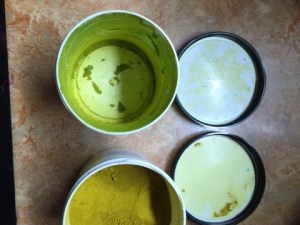


So maybe you have a favorite veil that you love so much, and you want to know what silk weight it is so you can shop for veils that will move and handle the same way. In the absence of a series of silks of various weights, how can you determine the weight of an unknown?
As I’ve demonstrated in a previous blog and video, the weight of silk is of immense importance in veil dancing. Momme (confusingly abbreviated mm) is the unit of weight used to categorize the heaviness of silk fabrics. It ranges from 3 or so for the gauziest of silk gauze to 30 or more for very heavy suitweight silks. The weights commonly used for belly dance veils are 5, 6, and 8 mm.
1 momme describes fabric that weighs 4.34 g/m2; thus, 5 momme fabric should weight 5 x 4.34 g/m2 = 21.7 g/ m2. You can determine the silk weight of a veil if you have a measuring tape and a balance or scales of some kind that will accurately measure to the nearest gram or tenth of an ounce. I weighed my silk pieces in my laboratory on an analytical balance, but you don’t have to have anything that fancy or accurate.
If you have a standard size rectangle veil, just weigh the veil to the nearest gram or tenth of an ounce, and refer to the table below. I’ve done the calculations for you.
| Momme Weight |
Weight in grams |
Weight in ounces |
| 5 mm |
65-68 g |
2.3-2.8 |
| 6 mm |
78-82 g |
2.75-2.9 |
| 8 mm |
104-108g |
3.7-3.8 |
Again, these weights are for a standard size veil. The reason I calculated a range is because in the silk industry, fabric sold as 45″ in width may actually fall anywhere from 43-45″ in width. So a standard size veil should have an area between 2.99 m2 and 3.135 m2 . Also, these measurements are for the fabric before the shrinkage that occurs during dyeing and/or washing. I take shrinkage into account when ripping my 6 mm silk for veils, but most veil-makers do not. Bottom line is if your veil is a little less than standard dimensions, proceed with these numbers. If you have one of my 6 mm silk veils, expect the area and weight to be a little over.
If you have a veil of some other dimension than the standard size, just calculate the area, convert if necessary to m2, and divide the weight in g by the area in m2 , then divide that amount by 4.34 get an approximation of the momme weight.
I worked all of this out because, in my search for a different source of 6 mm silk, I received a sample being sold as 6 mm from a Chinese textile company. The fabric felt too light to my hand. So I ended up calculating how much a veil of each weight should way, and I weighed pieces from all my silk suppliers. Sure enough, the sample was on the low end of 5 mm, so I passed on placing a bulk order with them. For the record, Dharma Trading pre-hemmed 5 mm veils are more like 4.5 mm by my measurements, and their 8 mm veils are spot on. My current source of 6 mm silk, Exotic Silk, is a bit under but reasonably close to 6 mm.
















 Check out the veil on the right: It has pale, underdyed areas. Blotches. Harsh transitions. The veil on the right is, by my standards, a big NOPE. Especially if I’ve used the veil on the left as advertisement. No, I didn’t ruin a veil just to make a point. The veil on the right is just unfinished, after the first round of vat dyeing. Numerous more dips are required to blend away harsh boundaries, melt away blotches, fill in pale, washed out areas.
Check out the veil on the right: It has pale, underdyed areas. Blotches. Harsh transitions. The veil on the right is, by my standards, a big NOPE. Especially if I’ve used the veil on the left as advertisement. No, I didn’t ruin a veil just to make a point. The veil on the right is just unfinished, after the first round of vat dyeing. Numerous more dips are required to blend away harsh boundaries, melt away blotches, fill in pale, washed out areas.








